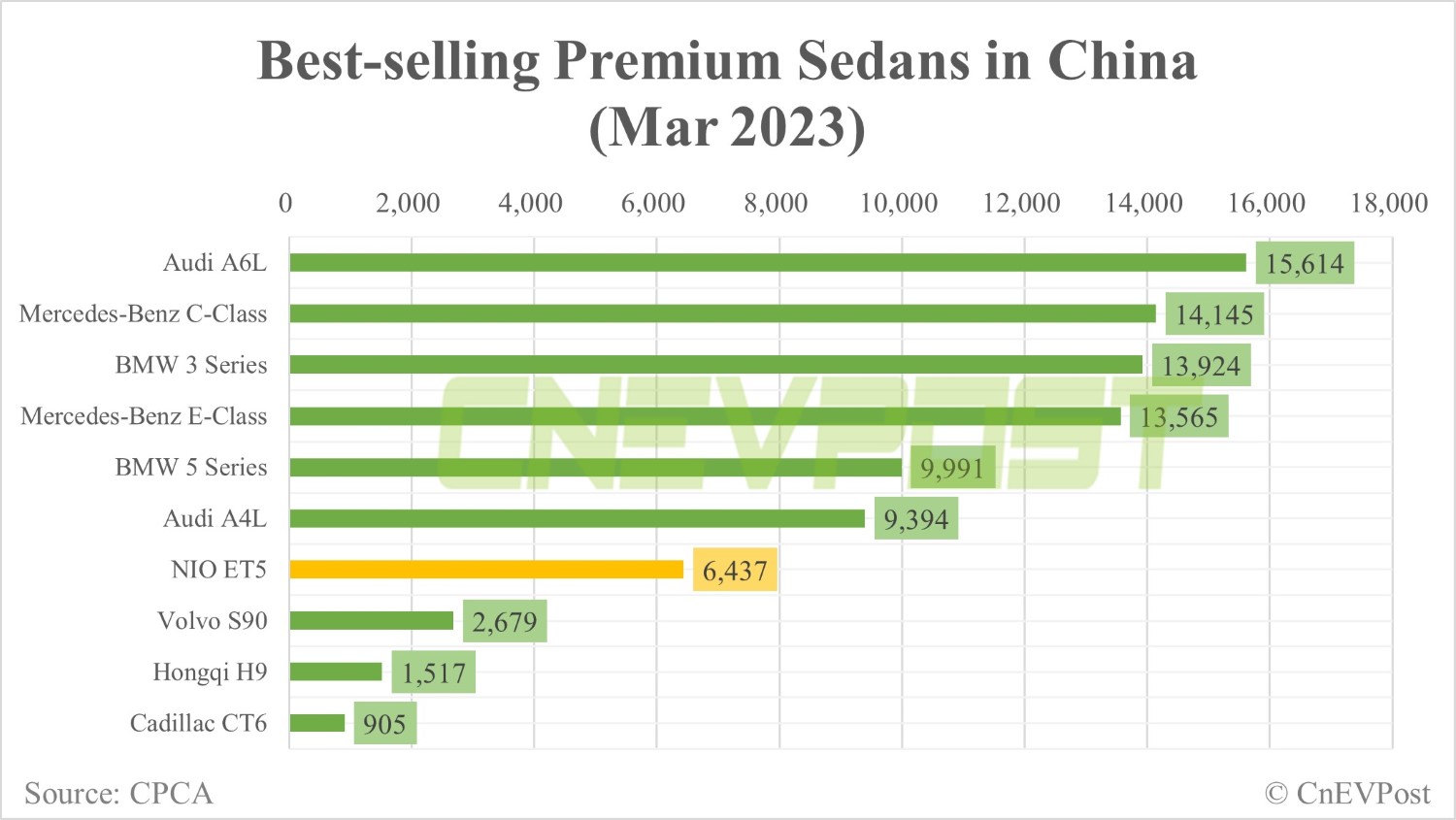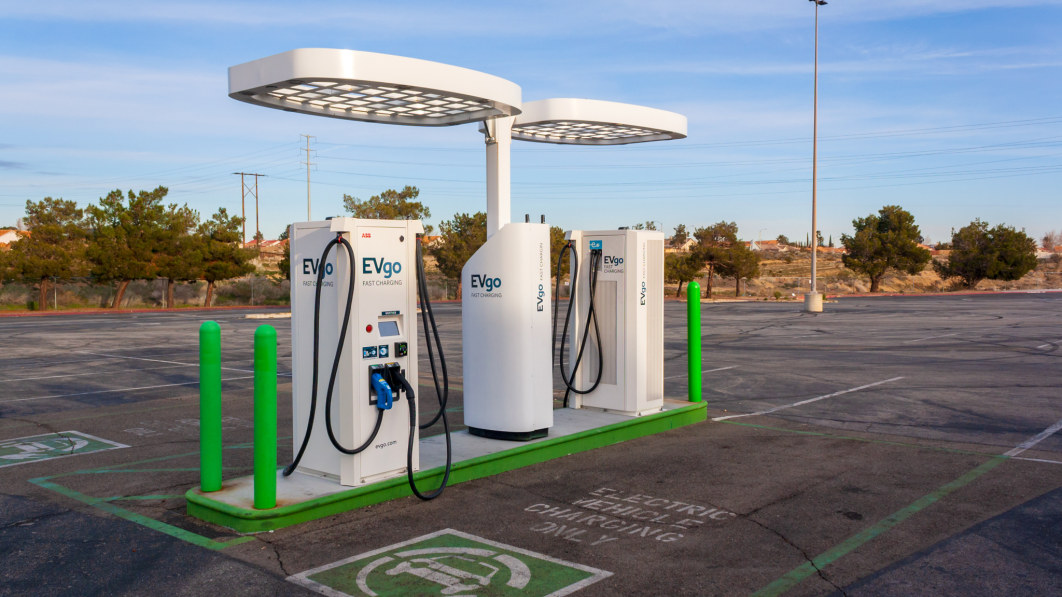The MG Cyberster was exposed in China. It is bigger than the Porshce Cayman and has more horses.
The post MG Cyberster EV roadster with 544 hp is ready for China appeared first on CarNewsChina.com.
The MG Cyberster was exposed in China. It is bigger than the Porshce Cayman and has more horses.
The post MG Cyberster EV roadster with 544 hp is ready for China appeared first on CarNewsChina.com.
The models ahead of the ET5 are all from German luxury automakers Mercedes-Benz, BMW and Audi. | NIO US | NIO HK | NIO SG

The ET5, which has been the main seller for NIO (NYSE: NIO) in recent months, saw its position unchanged in a premium sedan ranking last month.
With 6,437 retail sales in March, the ET5 ranked No. 7 in China for premium sedan sales starting at more than 300,000 yuan ($43,560), according to a list released today by the China Passenger Car Association (CPCA).
The ranking is the same as in February, when the ET5 sold 6,471 units at retail, as previously reported by CnEVPost.

The ET5 is the least expensive of the NIO product array, with a starting price of RMB 328,000. Deliveries of the model begin on September 30, 2022.
NIO delivered 10,378 vehicles in March, including 3,203 SUVs, and 7,175 sedans, according to figures the company announced on April 1.
Considering that NIO's sedans are only ET7 and ET5, this means that ET7 delivered 738 units in March.
The ET7 delivered 649 units in February. Earlier today, NIO announced that in addition to the new ES6, it will launch the 2023 ET7 on the first day of the Shanghai auto show on April 18.
Except for the ET5, none of the other models in the premium sedan sales ranking are battery-electric vehicles. The models with higher sales than the ET5 are all from German luxury car companies Mercedes-Benz, BMW and Audi.
The Audi A6L topped the list, with 15,614 retail sales in March, while the Mercedes-Benz C-Class ranked second with 14,145 units and the BMW 3 Series third with 13,924 units.
In January-March, the NIO ET5 ranked seventh with 18,703 units sold at retail. The model was No. 6 on the January-February list with 12,266 units sold.

The Mercedes-Benz E-Class was the best-selling premium sedan in China in the first three months with 40,261 units sold. The Audi A6L ranked second with 40,246 units. The BMW 3 Series ranked 3rd with 37,151 units.
As in March, the premium sedans that sold more than the ET5 in January-March were all from German luxury car companies.
($1 = RMB 6.8878)
The post NIO ET5 ranks 7th in top-selling premium sedan list in China with 6,437 Mar sales appeared first on CnEVPost.
For more articles, please visit CnEVPost.
Filed under: Green,Electric,Infrastructure

Continue reading These states rank highest for EV infrastructure
These states rank highest for EV infrastructure originally appeared on Autoblog on Tue, 11 Apr 2023 11:48:00 EDT. Please see our terms for use of feeds.
Permalink | Email this | Comments


 Last week at the New York auto show, Ram wowed with a new goal post for electric trucks: a targeted range of 500 miles for its 2025 Ram 1500 REV. That range number, introduced by Ram Brand CEO Mike Koval Jr., could make the 1500 REV king of the EV hill in what matters most to many shoppers, and second only to the Lucid Air sedan’s 516 miles...
Last week at the New York auto show, Ram wowed with a new goal post for electric trucks: a targeted range of 500 miles for its 2025 Ram 1500 REV. That range number, introduced by Ram Brand CEO Mike Koval Jr., could make the 1500 REV king of the EV hill in what matters most to many shoppers, and second only to the Lucid Air sedan’s 516 miles... Long awaited electric Passat was revealed in China with a 700 km range.
The post Volkswagen ID.7 production version revealed in China with 201 HP, public debut on April 18 appeared first on CarNewsChina.com.
DriveGPT will reshape the route of vehicle intelligence technology, allowing assisted driving to evolve faster and autonomous driving to come sooner, said Haomo CEO.

(Image credit: Haomo)
The popularity of ChatGPT has led players in the autonomous driving industry to start expecting more from artificial intelligence (AI) technology. Now, a Chinese startup has released a large model of self-driving cognition, becoming the first in the industry to do so.
Great Wall Motor-backed startup Haomo.AI Technology officially launched DriveGPT today, after it previewed the AI large model in February.
DriveGPT is the first generative large model for autonomous driving that will reshape the technological path to automotive intelligence, the Beijing-based company announced today at its 8th Haomo AI Day event.
The AI model builds RLHF (Reinforcement Learning from Human Feedback) technology by bringing in driving data for continuous optimization of self-driving cognitive decision models.
The goal of DriveGPT is to achieve end-to-end autonomous driving, and at this stage, it is mainly used to solve the cognitive decision problem of autonomous driving, said Gu Weihao, CEO of Haomo, at today's event.
DriveGPT has been opened to a limited number of partners, and the first batch includes Beijing Jiaotong University School of Computer and Information Technology, Qualcomm, Volcano Engine, Huawei Cloud, JD Technology, NavInfo, WEY Brand, and Intel.
GPT (Generative Pre-trained Transformer), essentially solves for the probability of the next word occurring, sampling from a probability distribution and generating a word with each call.
This continuous loop generates a sequence of characters for various downstream tasks. ChatGPT evolved on such a model.
On February 17, as the AI frenzy generated by ChatGPT continues worldwide, Haomo upgraded its large model of self-driving cognition to DriveGPT, calling it the first of its kind in the world of self-driving cognition.
DriveGPT completed model building and validation of the first phase of data with parameters comparable in size to GPT-2, the company said at the time, adding that DriveGPT will continue to introduce large-scale real data next to continuously improve its measurement.

At today's Haomo AI Day, Gu provided more technical details about DriveGPT.
Simply put, DriveGPT is the GPT large model in autonomous driving, which is also solving for the probability of the next Token, according to Gu.
Each call is equivalent to generating a Token based on a sequence of pre-trained Tokens, which are equivalent to a word in natural language processing, except that DriveGPT's Tokens are used to describe driving scenarios.
The sequence of Tokens is a complete time sequence of driving scenarios, including the next possible state of the entire traffic environment and the state of the car.
Under a unified generative framework, DriveGPT can do multiple tasks including planning, decision making and reasoning all together, according to Gu.
DriveGPT's pre-trained model uses 120 billion parameters and is based on 40 million production vehicles' driving data.
In addition to that, Haomo used partially screened human takeover data -- roughly 50,000 Clips -- for training the feedback model, according to Gu.
To easily understand the logic behind this, Gu gives an example:
Suppose we give a prompt to reach a certain target point, this prompt may come from the navigation of a map, or in the future it may come from human voice instructions during voice interaction.
DriveGPT will generate many possible driving styles, some aggressive -- change lanes continuously to overtake and reach the target point quickly, and some will be more steady -- follow other cars to the end.
If there are no other additional prompts, then DriveGPT will follow the optimal results from the feedback training and deliver a result that is more in line with most people's driving preferences.
Haomo is continuing to optimize DriveGPT, and the initial results will first be used in the new Mocha DHT-PHEV with Haomo HPilot 3.0, Gu said.
The Mocha DHT-PHEV is a model of Great Wall Motor's premium brand Wey, and Gu said the model will be available soon.
"We can also provide an excellent driving experience for city NOH (Navigation on HPilot)," Gu said.
In addition to city NOH, scenarios including city cruising, driving shortcut recommendations, and extrication, autonomous driving capabilities are also expected to see new breakthroughs, according to Gu.
"Ultimately we hope to arrive at the ultimate scenario of autonomous driving: driverless," he said, adding, "We believe that DriveGPT will reshape the technological path to vehicle intelligence, allowing assisted driving to evolve faster and autonomous driving to arrive sooner."

Notably, Haomo is one of the strongest players in the autonomous driving space, despite being an under-the-radar startup, especially compared to high-profile local electric vehicle companies.
Haomo was the former autonomous driving division of Great Wall Motor and became an independent company in November 2019. Its core team members come partly from Great Wall Motor's smart driving R&D team and partly from local tech companies.
In September 2022, Ora Funky Cat and Wey Coffee 01 from Great Wall Motor achieved results comparable to the Tesla Model Y in a European safety test.
Both the Ora Funky Cat and the Wey Coffee 01 were equipped with assisted driving technology provided by Haomo, which was a major reason for their high scores, especially on Safety Assist, at the time.
At the 7th AI Day event held today, January 5, Haomo announced MANA OASIS, an autonomous driving computing center launched by it and Volcano Engine, a cloud service platform owned by ByteDance, with a total computing power of 670 PFLOPS, the largest in China at the time.
The computing power support provided by MANA OASIS was key to the training and technology becoming available for DriveGPT, Gu said today.
Separately, Haomo chairman Zhang Kai said at today's event that in addition to the new Mocha DHT-PHEV, the second HPilot 3.0-equipped model, Wey Lanshan, will be launched this year.
Haomo's HPilot has been installed in nearly 20 models and has assisted users to drive more than 40 million kilometers, Zhang said.
In overseas markets, vehicles equipped with HPilot have been shipped to regions including the European Union and Israel and delivered to local consumers.
Vehicles equipped with the driving assistance system will be available in the Middle East, South Africa and Australia, and the Mexican and Russian versions of HPilot will be in mass production soon, Zhang said.


The post Haomo's self-driving ambitions leap forward with launch of DriveGPT appeared first on CnEVPost.
For more articles, please visit CnEVPost.
Filed under: Green,Weird Car News,Technology,Coupe,SUV,Luxury,Performance

Continue reading Watch BYD's new DiSus body control system make a car dance and jump
Watch BYD's new DiSus body control system make a car dance and jump originally appeared on Autoblog on Tue, 11 Apr 2023 10:33:00 EDT. Please see our terms for use of feeds.
Permalink | Email this | Comments